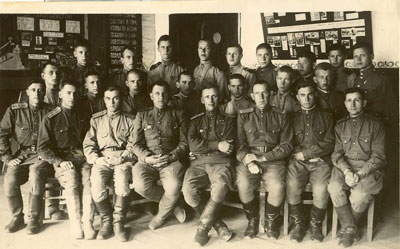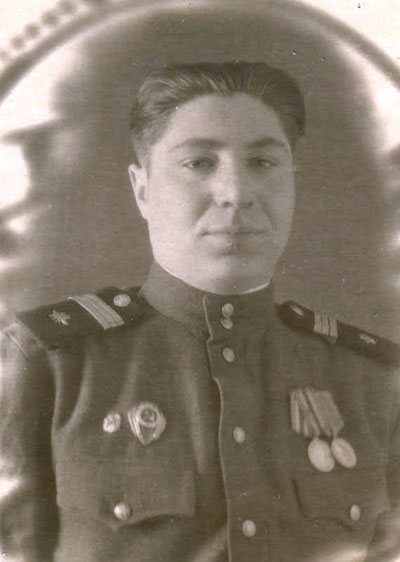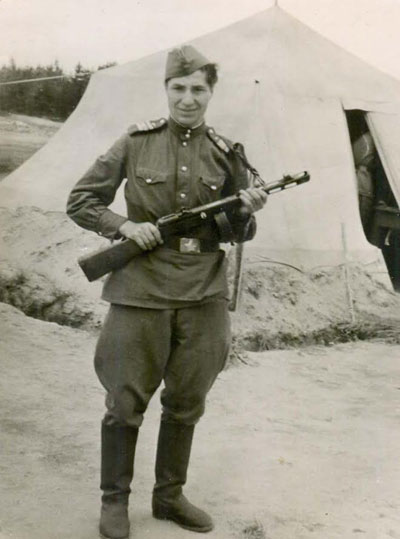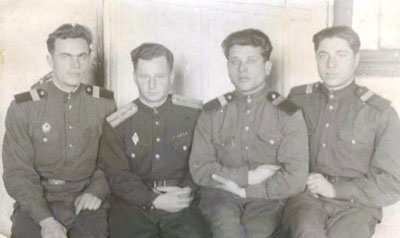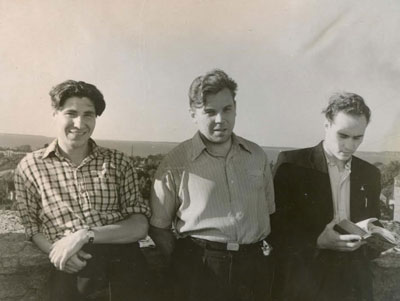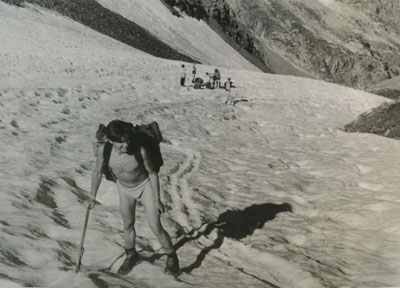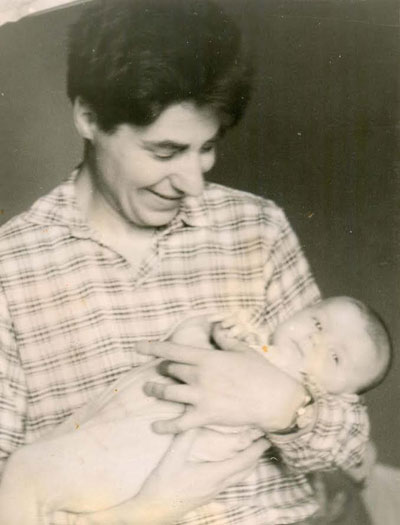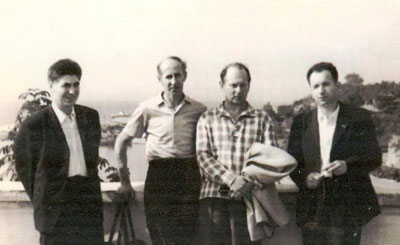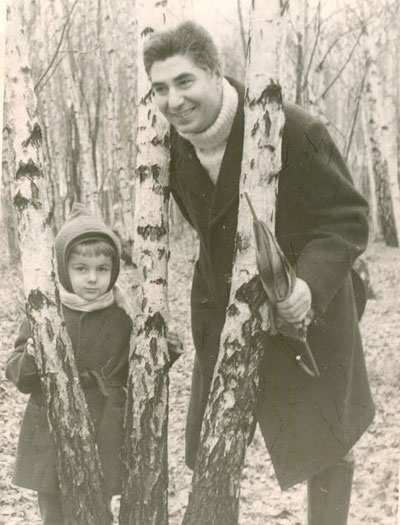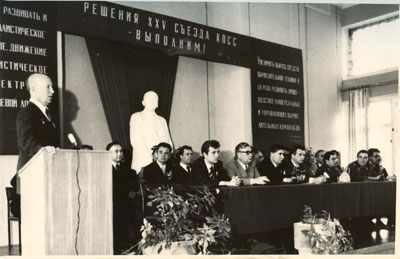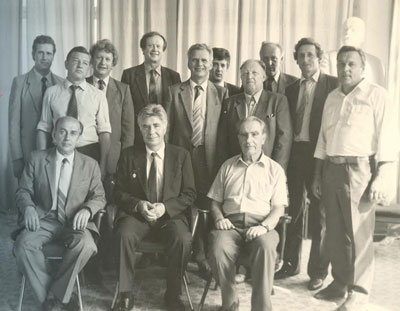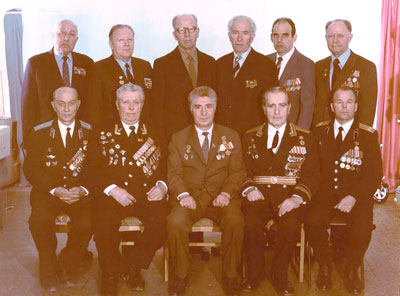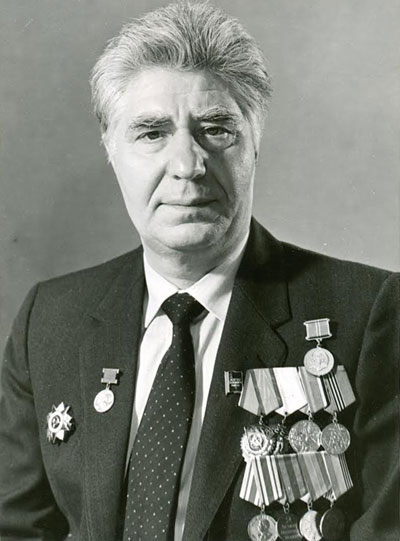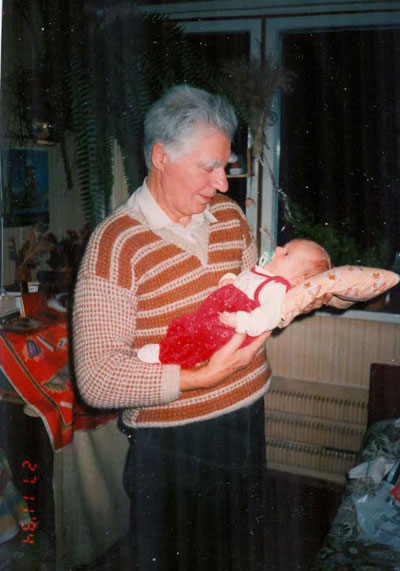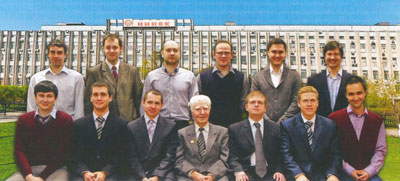Yuri Vasilyevich Rogachev
Home → Hall of Fame → Rogachev Yury Vasilievich
Translation by Alexander Nitusov
Yuri Rogachev was born on the 18th August of 1925 not far from the town of Kalinin (now Tver).
In 1943-1950 he served at the Soviet Army as a radio master.
In August of 1945 participated in the military operations against Japan in Manchuria.
After that he graduated from army radio courses, at a communications regiment located in the USSR Far East and, from 1946, continued as military radio service master.
After demobilization Rogachev came to Moscow, where – from June 1950 till September 1952 – he was working at the Power Institute (USSR Academy of Sciences) as an electrical mechanician, at the laboratory of electrical systems headed by academician Isaak Bruk. There he learned the first time about electronic computing machine and, under guidance of Nikolay Matyukhin (then 24), took part in development of components and arithmetic unit for digital computer M-1.
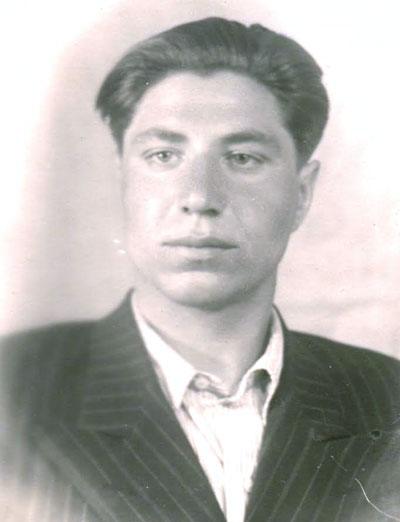
In Moscow; on the threshold of scientific life
Rogachev also performed series of successful experiments for the purpose of replacing electronic tube diodes 6×6 with small-size copper-oxide rectifiers KVMP-2-7 in logical circuits of the computer. Thus M-1 became the world's first computer with semiconductor based logical circuits.
In the period between 1951 and 1952 school years, in parallel with work, he completed his -interrupted with war- primary education, what was the necessary condition for receiving university education. After that, in 1952, he entered the faculty of radio at the Moscow Power-Engineering Institute, from which he successfully graduated in 1958. At that time this faculty was one of the first places in the country where -the greatly needed- high qualified electronic engineers were educated.
After graduation Rogachev returned to academician I.S. Bruk's research center, already as an engineer. Then, it was already a new institute – “Institute of Electronic Control Computers”, which Bruk founded by that time.
In 1958-1960, he took part in development of new computer M-4 and in supervising of its serial production by an electromechanical plant in small town of Zagorsk (near Moscow).
In 1960 a special new laboratory (lab. #2) was established at the institute. Mikhail Kartsev, Rogachev's age-mate and a close life-long friend, was put in charge of it and Rogachev was appointed there as a senior engineer.
He was in charge of development and, subsequently, organization of manufacturing, of the information primary processing unit (IPPU). When it was completed he should produce a modified variant of the computer M-4, named M4-M (which was the M-4 combined with IPPU). It was intended for an ultra-high frequency band radiolocation station control. Its signals arrived for processing in much higher tempo that could be processed by the M-4, therefore, a computer with higher performance was needed.
Rogachev solved the problem on principally new level. He developed basically new system of logical elements, which enabled computing with very high performance rate (for the level of that time, of course).
His system was based on levels forming inverter designed as a current switch, with the use of high-frequency transistors, and multistage diode logic circuits. A structural novelty was introduced: functional circuit of the unit contained broadband registers, what made possible parallel processing of up to 16 radar signals. Such design solved the problem of M4-M coupling with the radiolocation station, and the problem of its integrated performance, what was necessary for the ultra-high frequency band station real-time mode working control.
In November 1962 the institute received a governmental directive with order to start development of serial computer M4-2M with the aim of building a new super-performance computing system on its basis.
Michael Kartsev was appointed as its chief designer and Rogachev became his official deputy and the first assistant. Rogachev improved its system of elements by essential extension of their logical possibilities and increasing output capacity. Hardware components of that system – the sells, made possible to compose a number of logical circuits essentially different from ordinary variants. He took advantage of the high unification level of components and links between them and introduced his – already tested in practice – technologies of project documentary development and release, as well as the devises/hardware manufacturing. All that created possibilities for starting serial production of new computer M4-2M directly at the factory without preliminary modelling and making experimental pieces.
In 1965 the department of special project development was established at the institute. M.A. Kartsev became its director and Rogachev was in charge of the special laboratory №2 – leading laboratory of the department and, simultaneously, he was appointed as the Kartsev's deputy. From that time Rogachev took active part in development of computer architecture, he organized and supervised the works during technical documentary development, supervised, as the author, manufacturing of the computers at factories and bringing them into operation at customers' enterprises.
In 1965-1967, specialists of laboratory №2 created peripheral complexes SVU-79-1(СВУ-79-1) and SVU-79-2 (СВУ-79-2) for computing structures and local computer network SPRN (СПРН).
Scientific results of Rogachev's work, obtained during development of computer М4-2М, formed the basis for his dissertation which he successfully defended (and received the degree “Candidate of Sciences”).
In 1967 the institute's Department of Special Development was administratively transferred over to the “mighty” USSR Ministry of Radio Industry, where it served as the basis for establishing the “Affiliate №1” of the special design bureau “Vympel” (pennon). Rogachev was its chief engineer and (“as usual”) the deputy of the chief designer Mikhail Kartsev.
On the 29th of September 1969, according to the government's directive, the Affiliate №1 was given new task – development of principally new computer M-10 and computer complex for control center of a missile attack early warning system (MAEWS), which was developed and produced by the Radiotechnical Institute under supervision of its director academician A.L. Mints.
In this connection the Affiliate №1 was renamed into Affiliate of RTI. Kartsev was the chief designer of M-10, and Rogachev – one of his deputies. The new computer to be designed, should demonstrate performance of no less than 5 million ops (MIPS), and the RAM capacity of no less than 5 Mbyte. Kartsev decided to implement in it his previous invention – the architecture of so-called “numeral cluster” from the computing complex M-9 – the pilot project of which was composed as early as in 1967. M-10 was a multiprocessor vector-parallel computing machine of the third generation. Its circuitry was based on microcircuits of series 217 “Posol” (Ambassador).
In this work Rogachev perfectly demonstrated his talent of a team leader. During development of M-10 Kartsev had to interrupt his work and to stay in a hospital for a long time, unfortunately he had had a strong heart infarct.
Rogachev alone had to take the responsibility and perform both all Kartsev's and his own scientific and administrative functions. Luckily, his rich experience, organizational abilities as well as moral support and assistance of his enthusiastic scientific and engineering collaborators made possible successful completing of the work. The new computer was really an unique machine. The manufacturing plant eventually received complete set of project documentary and, by the time when Kartsev's health condition improved and he returned from the hospital, all hardware for the experimental piece had been already manufactured at the electromechanical plant in Zagorsk and handed over to the Radiotechnical Institute. Soon after serial production of the computer was launched.
In 1976 both computer M-10 and the first computing complex, based on it, as a part of MAEWS control center hardware, successfully passed testing performed by the state commission and were put into regular operation.
All that became the reason for extending the Affiliate №1 and transforming it into the Scientific-research Institute of Computational Complexes (SICC).
The scientific team, which produced the computing complex and put it into regular operation, was awarded the USSR State Premium.
In 1975 Rogachev celebrated his 50 years jubilee.
M.A. Kartsev wrote him a letter of congratulation, which contained, among other, the following:
„ ...You sacrificed almost a quarter of a century – a half of your 50 years life – to our team. You've made a glorious professional way from a radio-assembler to a candidate of technical sciences, to become the chief engineer of our institute. We recognize and highly evaluate your impressive knowledge, your organizational experience and your significant contribution to establishing of our scientific team, to forming the institute in general, and also to all our projects beginning from the first Soviet computer M-1 up to the most recent, and the most powerful machine M-10...“.
“We also sincerely hope to continue our joint work for at least the next quarter of century, in our consolidated and dynamical institute where you have got so many genuine and faithful friends. I believe that we together will devise not a little more new machines...”.
Since 1977 computer M-10 was produced with new components, and was marked M10-M. New internal memory units were designed, they were based on the big integrated circuits which were already in serial production by that time. Their implementation reduced amount of the hardware almost two times, without losing a single byte of total computer memory. M-10 and M10-M were fully hard- and software compatible.
Those machines formed solid basis for development of special computing complexes 5К31, 5E52, 63I6, 65I6, 68I6, 17L6, 70I6, 76I6. Rogachev, as scientific supervisor, made significant contribution to organization of their serial production and of their regular operation at the customers' organizations.
Parallel to the scientific work he took active part in the institute's administrative activity. In 1973 construction of a new laboratory building started. In December 1974 he already signed the act of successful completion of the first planned working period. The new building was completely ready in 1975. Ten years later, in 1985, one more laboratory building was built. Its total space was more than 20.000 sqm. Rogachew also made many efforts to provide the institute with the most advanced scientific and technical equipment, including all what was necessary for creation and operation of special simulation stand based on M10-M design.
Supercomputer M-13 was a new step in the institute's scientific progress.
M-13 was a multiprocessor vector parallel-conveyor computer of the fourth generation. Capacity of its internal memory (RAM) reached 34 Mbyte, throughput of the multiplex channel – up to 100 Mbyte/sec, central processor unit performance – 50 MIPS, equivalent performance of the unit for functions processing reached 2.4 Billion ops (BIPS).
From 1980 till 1983 Rogachev was a deputy of the M-13 chief designer (M. Kartsev).
Although the M-13 project documentation was developed by the institute within the planned time and the experimental machine was assembled by special plant and successfully tested, its serial production encountered some unexpected problems. Thus, all documentation was sent to the manufacturing enterprises in town Zaporozhje (Ukraine) and also another one, but, because of some bureaucratic chaos there, production of M-13 started neither in 1982 nor in 1983. In May1983 M. Kartsev suddenly died of massive heart attack and Rogachev was appointed as the institute's director and the chief designer of M-13.
Due to his immediate and numerous efforts the institute was re-subjected to another ministerial department and the order for M-13 manufacturing was also transferred, this time to the electro-mechanical plant in Zagorsk (near Moscow). Production of M-13 successfully began there in 1984, and in 1986 the first computer was tested, mounted at the institute and put into regular operation. The Zagorsk plant started serial production of these computers for powerful computing complexes.
In 1986 Rogachev's institute was awarded the order “Red Banner of Labour” (“For outstanding contribution to development of the Soviet computer engineering...”).
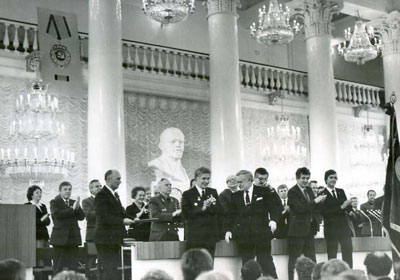
1986. Moscow, special governmental hall for festive occasions. The institute is given the order “Red Banner of Labour”
In 1986-1987 Zagorsk plant produced, and put into operation at customer's place, the first series of six computers M-13 made for computing complex 4MPO. This complex was quickly and successfully assembled. Production continued; altogether about 20 series of M-13 were manufactured.
Yuri Rogachev was satisfied – his main task of the chief designer was completed (as he evaluated it), so, in August 1988, he applied to the ministerial board (the USSR Ministry of Radio Industry) for retirement from that position, as he was already 63 (in the USSR, 60 was the permitted retirement age).
From the beginning of his scientific career Rogachev was always an assistant and a true friend of Michael Kartsev. He has made significant contribution to all Kartsev's computers, of all four generations (one of the world's best computer line) with his knowledge, labor and organizational talents.
On the 22nd of August 1988 Yuri Rogachev was awarded “Honorable personal pension of the Russian Federation” (special, exclusive kind of a pension).
There is no need to say that his connections with the institute continued. He remained there as the director-general's scientific expert-consulter. When the institute was transformed into a joint stock company (“M.A. Kartsev's Scientific Research Institute of Computing Complexes”) he became a member of the board of directors and, since 1997 he was the chairman of this board.
In 1998 he published the book, “Computer engineering from M-1 to M-13 (1950-1990)” dedicated to the memory of Mikhail Kartsev. In his book Rogachev described the history of the institute's scientists and engineers creative development.
In 2005 V.S. Mukhtarulin – the director general of the institute wrote him a letter of congratulation to his 80 years birthday.
Among others there were the following words: “... the veteran of the Great Patriotic War; after demobilization you worked several years as a common worker, and having started from that you eventually became an outstanding engineer, scientist and a leader of a big scientific team...”
After the death of M. Kartsev you have risen our standard that was falling down from his hand, and successfully headed our institute more than five years. You took part in almost all our projects, also as the chief designer. At present you are still working at the responsible place- at the chairman's of the council of director’s position.
Yuri Rogachew has been awarded the USSR State Premium.
He is also decorated with orders: “The Great Patriotic War” (1985), “The Sign of Honor” (1971), and with numerous medals – among them, “For Honorable Radiomaster”, „Victory over Japan“, “For Valorous Labor”, “100 years Jubilee of V.I. Lenin”, and some others.
Published in museum, 25.03.2016





